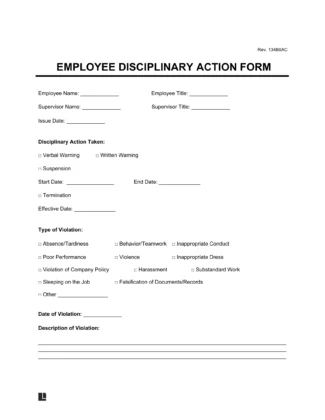
If an employees behavior or performance isn’t meeting expectations then you can use an Employee Disciplinary Action Form.

Published July 6, 2023
Written by Josh Sainsbury | Reviewed by Brooke Davis
An employee disciplinary action form is a formal document acknowledging situations where employees fall short of their employer’s expectations. These instances may involve quality concerns, performance issues, behavioral misconduct, or safety-related incidents deemed necessary for resolution by organizational leaders.
An employee disciplinary action form should be used when addressing immediate improvement needs related to behavior or performance issues.
It serves two purposes: documenting the specific issue at hand and providing a basis for monitoring the employee’s progress in rectifying the concern in the future.
Disciplinary action in the workplace encompasses various behaviors and situations that many businesses address. Examples of disciplinary actions may include, but are not limited to, the following categories:
When developing an employee disciplinary action form for your own business, you’ll want to include elements like the following:
Disciplining an employee requires careful handling. Follow these key steps to ensure an effective disciplinary process:
Provide a verbal warning unless the situation involves highly inappropriate behavior or severe safety concerns. Communicate the issue to the employee, explaining why it is problematic and emphasizing the importance of avoiding future occurrences.
If the issues persist, such as ongoing productivity or quality problems, issue a written notice for the second violation. Include detailed information outlining expectations and potential consequences or corrective actions if improvement does not take place.
This document serves as formal documentation for the employer’s expectations and the consequences of non-compliance.
A formal employee review may be necessary in cases of repeated violations. Involving the human resources department may be appropriate at this stage.
Depending on the severity of the situation, more significant corrective actions such as suspension or termination may be considered.
When creating an employee disciplinary action form, follow these crucial steps to provide clarity and safeguard your organization’s interests:
Include a section to capture essential details such as the employee’s name, title, direct supervisor’s name, and the date of the incident. This information will be vital for future reference.
Provide a detailed account of the disciplinary action involved. Specify whether it is a verbal or written warning, suspension, or any other long-term action. Include start and end dates for any suspensions, and provide checkboxes for supervisors to indicate the type of violation.
Allocate sections for additional context to help others understand the incident. Allow space to describe the violation in the reporter’s own words. Provide room to outline the corrective plan, consequences for failure to improve, and an employee statement.
Establish a timeline for potential follow-ups on disciplinary action.
Designate a space for the employee receiving the disciplinary action and their supervisor to sign and date the form.
Use the following employee disciplinary action form sample as a guide when creating your document: